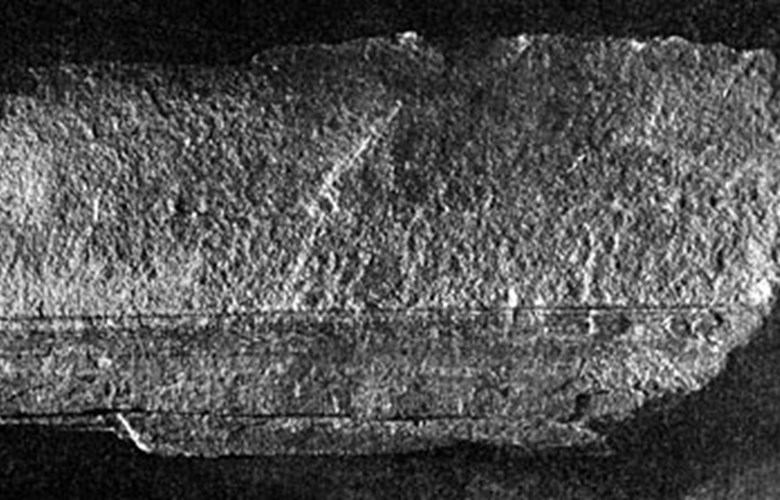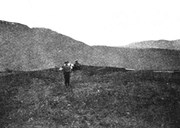The find
It was the farmer Nils J. Eggum who found the stone while he and his son Johannes were ploughing a field on 5 June, 1917. They were ploughing on a hill called Bergahaugen, located so far out on the heights of Eggja that there is a fine view down the valley to Stedje, "Fjøra" (the centre of Sogndal), and the fjord. The plough hit a big slab. They turned it and discovered that there were runic inscriptions on the other side of the slab. Nils took contact with Gert Falch Heiberg, who was in charge of the "De Heibergske Samlinger - Sogn Folkemuseum", and after a quick inspection, he immediately sent word to the archaeologist Haakon Shetelig. He came to Eggja as quickly as possible, and studied the stone and the site where it was found.
Praise from the archaelogist
Nils and Johannes were praised for the way they had handled the stone. It had been done "with a consideration that deserves the highest praise", professor Magnus Olsen wrote in his comprehensive report of the Eggja stone in 1919. Studies of the find stated that the stone must have dated from the 7th century AD. The runic stone was moved to Bergen Museum and where it still is. "De Heibergske Samlinger - Sogn Folkemuseum" at Kaupanger has a plaster copy of the stone.
The stone
The Eggja stone itself is 1.6 metres long and 0.71 metres wide. It contains runes from the early runic rows. The runes are placed in two long and one short row on the upper part of the flat slab. The upper row of runes is about 1.2 metres long, probably containing 110 characters (some runes are damaged or have eroded, thus making it difficult to ascertain the exact number). The lower row of runes is about one metre long with about 7o characters. In between these two rows there is a short row with nine or ten runes that are turned on their head and are also turned to the left.
The inscription
The Eggja stone has the longest inscription with this early row of runes in Europe. The language is Proto-Norse (ancient Norse), a common Germanic language spoken in the non-Roman parts of Europe towards the 6th century AD. The content points toward a newer age, because it is a lay (a short poem) - the type of poetry most commonly used in the Viking Age. This is an early type of lay with many unclear poetic paraphrases.
Magnus Olsen's interpretation
The oldest - and best known - interpretation of the inscription on the stone was carried out by professor Magnus Olsen as early as 1919. In his opinion, the inscription was an epitaph to the master of the household at Eggja, who had been treacherously killed. His corpse had been put on a sled and pulled up to the farm. This is Olsen's interpretation:
Not hit by sun
And not carved by knife.
This (stone) stenched the man with blood
And scraped with it (blood) on oarlocks of a (?) sled (boat?)
Who of the flock has come hither to men's land.
The fish, swimming resolutely,
Through the stream of blood.
The bird, which would shriek if it could cut into the corpse.
For Ormar an avenger is raised.
Other interpretations
Later on other researchers have put forward highly deviating interpretations. In 1985, the prominent runic expert Ottar Grønvik, Ph.D., published a book on the Eggja stone. He agrees with Olsen that the inscription has to do with a funeral. He interprets the first part of the inscription as an account a dramatic shipwreck. In the second, more religious/ritual part, it is, according to Grønvik, a case of a "man fish" leading the deceased across to the "other side", "the land with the shining meadows", that is, to the realm of the dead. Grønvik sees here a firm belief that there is a land of bliss for those who perish out on the ocean, and that there is a divine helper who leads the deceased across to this place.
The witchcraft tradition
The last lines in the inscription Grønvik reads as a prayer that the grave will not be sought out by "the man who wails over naked death" or by "strangers". This interpretation shed light on the old Norse "seid" (witchcraft) tradition. This tradition must have existed as a kind of religious out-group culture, with supporters who went beyond the accepted norms of cult practise. Grønvik's interpretation is but one of many, and the present status is that many questions are still unanswered as to what is actually carved into the stone. In many ways the stone is still a riddle.
The unique stone
The most important reason why it has been so hard to interpret the runic characters on the stone, is the fact that it is so unique. Most inscriptions in Proto-Norse are short, sometimes consisting of only one word. Consequently, there is little material that can be used to compare this stone with. In addition, when many of the runic characters are missing or barely visible, this opens up for many interpretations. At any rate, what researchers seem to agree on is that the inscription must have something to do with a ritual, and that it is of a magic character.
A literary culture
Even if we cannot be sure about the meaning of the inscription, the Eggja stone nevertheless gives a fascinating picture into the rural community in the 7th century AD. In the village of Sogndal there were artists who knew how to write a lay, which proves that this community was part of a literary culture, as well as showing that there were contact points to larger literary and cultural environment.



